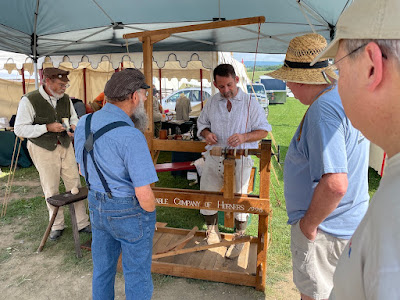This past Saturday I attended the Gunmakers Fair at Kempton. This is the successor to the Dixons Gunmakers Fair, which was last held in 2019. If you are into black powder arms and history of the 17th through the19th Centuries, it's worth the visit.
I took some pictures.
Turning a powder horn base on a treadle lathe:
Two examples of 17th Century Armor:
Gonnes:
From top to bottom, a flintlock, transitional flintlock, a paddle butt wheel lock carbine, and a couple of wheel lock pistols:
A closeup of the dagger from the previous picture. The guard incorporates a spanner for a wheel lock, while the handle is a flask for priming powder:
Note too the powder flask made from a hollowed out antler.
There was a vast amount of guns, knives, and other articles that I did not photograph.
After finishing up at the Fair, I hit Dixons Muzzleloading Shop on the way home. As expected it was busy. Aside from black powder guns they also carry items they pick up at garage sales or that people bring in. Over the years I've bought some neat old tools there. On this visit I grabbed a couple of nice old American-made pliers, which I'll put to use.
Aside from the tools, Dixons also had a large supply of empty cases and bullets that probably came from an estate. For $10, I found an unopened box of 100 .358 swaged lead semiwadcutter hollow point bullets by Alberts which date from the 1980s or 90s. We used to load Alberts bullets back then but they went out of business. I plan to load them in .38 Special to service load levels.















